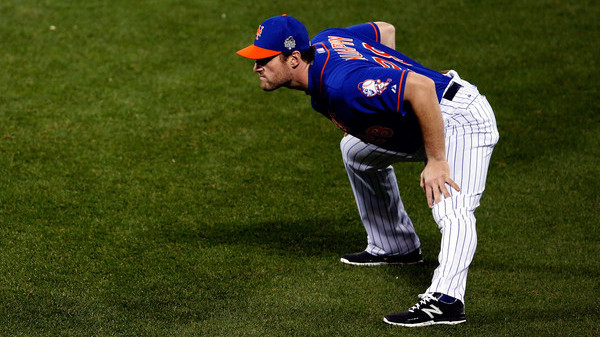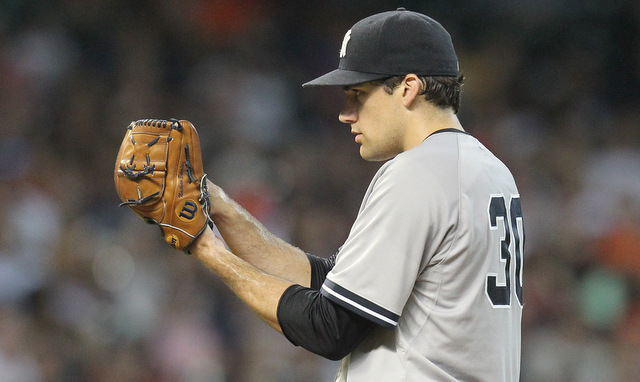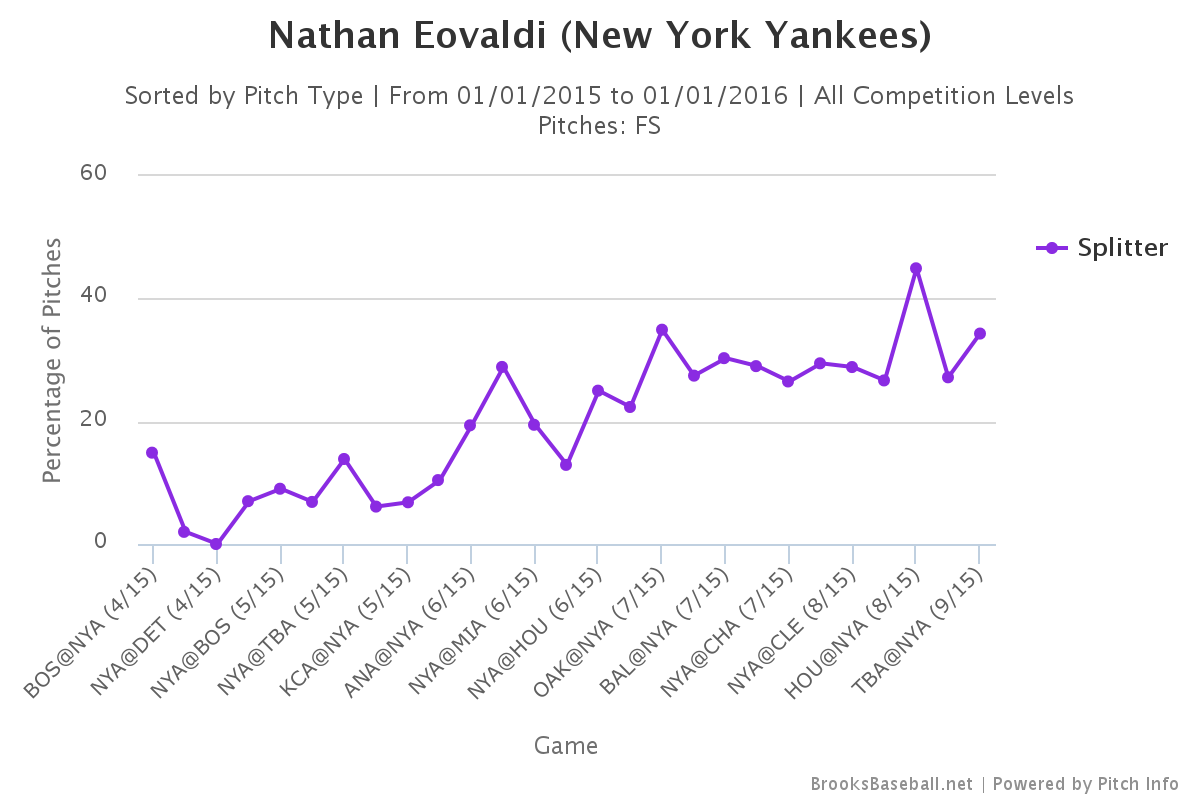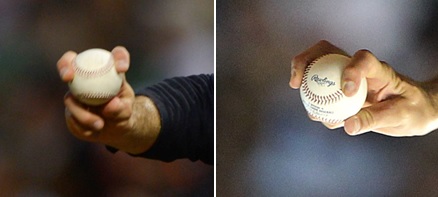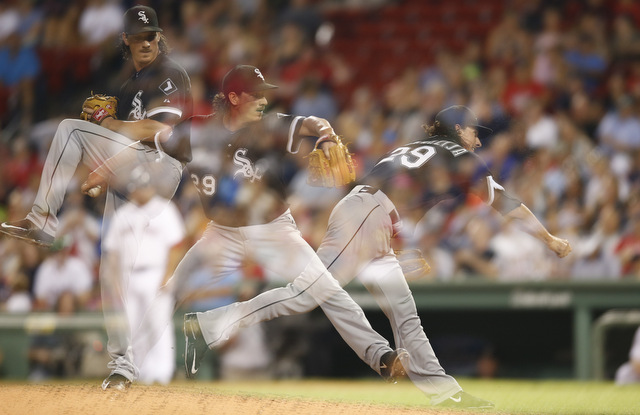
At the moment, the Yankees have seven starters for five rotation spots. That includes Ivan Nova and Adam Warren, who are depth arms and not oh gosh we need to clear a rotation spot for him arms. Masahiro Tanaka is coming off offseason elbow surgery, however, and the trio of Nathan Eovaldi (elbow), CC Sabathia (knee), and Michael Pineda (forearm) all got hurt in the second half.
Those seven starters come with seven question marks — Nova stunk this year, Warren has never spent a full MLB season as a starter, Luis Severino is a 21-year-old kid — and while adding rotation help may not be a top priority this offseason, it would make sense to at least explore the market. After all, the Yankees had those seven guys this past season and they still needed Chase Whitley, Chris Capuano, and Bryan Mitchell to make some starts.
The 2015-16 free agent class is loaded with starters. You’ve got aces, mid-rotation guys, reclamation projects, you name it. We haven’t seen a free agent class this deep with arms in a very long time. One of those arms is right-hander Jeff Samardzija, who is coming off a disappointing season but nevertheless is expected to receive a significant contract this winter. The Yankees have already been connected to him. Let’s dive in.
Recent Performance
Like I said, the soon-to-be 31-year-old Samardzija had a disappointing 2015 season with the White Sox. The idea players cost themselves money with poor performance gets thrown around too much — no, those two bad weeks in September won’t kill a guy’s free agent value — but Samardzija definitely did. He was potentially looking at $100M+ this offseason. Anyway, here are his last three years.
| IP | ERA | FIP | K% | BB% | GB% | HR/FB% | RH wOBA | LH wOBA | |
|---|---|---|---|---|---|---|---|---|---|
| 2013 | 213.2 | 4.34 | 3.77 | 23.4% | 8.5% | 48.2% | 13.3% | .309 | .342 |
| 2014 | 219.2 | 2.99 | 3.20 | 23.0% | 4.9% | 50.2% | 10.6% | .279 | .292 |
| 2015 | 214.0 | 4.96 | 4.23 | 17.9% | 5.4% | 39.0% | 10.8% | .302 | .357 |
| 2013-15 | 647.1 | 4.09 | 3.73 | 21.4% | 6.3% | 45.6% | 11.5% | .297 | .332 |
Okay, so which one is the real Samardzija? Is it the guy who was okay at best in 2013, the guy who was an ace in 2014, or the guy who led the league earned runs and total bases allowed in 2015? For some reason I feel like the answer is none of the above. The truth is probably somewhere between 2014 and 2015, which is an incredibly wide range of possible outcomes.
I think it’s important to note the White Sox had one of the worst defenses in baseball this season, which surely contributed to Samardzija’s trouble preventing runs. They turned relatively few balls in play into outs behind him. The bad defense doesn’t explain a five percentage point drop in strikeout rate or the ten (!) percentage point drop in ground ball rate*, however.
* Samardzija went from 0.82 HR/9 last year to 1.22 HR/9 this year, and that’s all due to the sudden lack of ground balls. His HR/FB% rate was basically identical those two years.
Let’s take a deeper look at at the type of contact Samardzija has given up the last few seasons and see what’s going on there.
| GB% | FB% | LD% | IFFB% | Pull% | Oppo% | Soft% | Hard% | |
|---|---|---|---|---|---|---|---|---|
| 2013 | 48.2% | 31.4% | 20.4% | 10.1% | 36.5% | 23.0% | 17.8% | 28.2% |
| 2014 | 50.2% | 30.5% | 19.3% | 10.6% | 38.0% | 24.4% | 19.9% | 24.7% |
| 2015 | 39.0% | 39.8% | 21.2% | 10.1% | 40.2% | 26.4% | 18.7% | 26.7% |
| 2013-15 | 45.6% | 34.1% | 20.3% | 10.2% | 38.3% | 24.7% | 18.8% | 26.5% |
| MLB AVG | 45.3% | 33.8% | 20.9% | 9.5% | 39.1% | 25.7% | 18.6% | 28.6% |
Samardzija’s hard and soft contact rates have been right in line with the league average the last few years. Same goes for pull and opposite field rates. If there was a lot of hard contact or a spike in pull rate — suggesting hitters were getting around quicker on his stuff — it would be a significant red flag.
Fly balls are not necessarily a bad thing — most fly balls are catchable, routine plays — and Samardzija has gotten a bit more infield pop-ups than the league average pitcher the last three years. Pop-ups are almost as good as strikeouts. They’re as close to a sure out as there is in this game. Still, Samardzija’s ground ball rate fell and his fly ball rate climbed big time in 2015, and that’s something we can’t ignore.
Something caused those changes in Samardzija’s fly ball and ground ball rates this year. They’re just the symptoms of the problem, not the problem itself. Samardzija’s stuff and pitch mix may have the answers, or at least point us in the right direction.
The Stuff
At this point of his career Samardzija is a true five-pitch pitcher. He stopped toying around with a changeup and a curveball a few years ago, instead settling on a splitter and slider as his go-to secondary pitches. Three different fastballs — four-seamer, sinker, cutter — round out his repertoire. Here’s a real quick average velocity breakdown from Brooks Baseball:
That’s a pretty significant drop in four-seamer velocity, right? Samardzija lost 1.3 mph off his heater last season. The velocity drop on his other pitches — sinker (.52 mph), slider (.97 mph), cutter (.64 mph), splitter (.90 mph) — is not as severe but is still notable. Samardzija was still one of the hardest throwing starters in baseball last season, that’s important to remember, but there was enough of a velocity drop across to board to make you notice.
Samardzija’s pitch selection the last three years is pretty interesting. Most guys who throw five pitches really throw like three pitches and occasionally flash the other two. That’s not the case with Samardzija. He throws all five regularly. Here’s the data, again via Brooks Baseball:
Samardzija threw all of his pitches at least 12.7% of the time last year and didn’t throw one more than 24.7% of the time. He doesn’t throw the splitter to righties and he doesn’t throw the slider to lefties, which makes sense, but otherwise Samardzija uses everything. This isn’t Tanaka throwing that slow curveball four or five times a game, for example.
I am not at all surprised to see Samardzija threw his cutter significantly more often last season. White Sox pitching coach Don Cooper is renowned for teaching the cutter and getting his pitchers to emphasis it. Cooper taught Jose Quintana and Gavin Floyd a cutter in recent years and turned their careers around. Samardzija always threw a cutter, but he nearly doubled his usage of the pitch this season from just two years ago.
And perhaps that is part of the problem. The additional cutters — and additional sliders, I’m guessing some of those sliders were cutters that maybe broke more than usual and wound up being classified as sliders — came at the expense of sinkers more than anything, and hey, that might explain the sudden drop in Samardzija’s ground ball rate. Then again, his grounder rate was down across the board, on all his pitches. Again via Brooks Baseball:
MLB Averages: Four-seam (37.9%), sinker (49.5%), slider (43.9%), cutter (43.0%), splitter (47.8%).
So much for the idea that fewer sinkers led to fewer grounders. Well, no, that is true to a certain extent for Samardzija, but the ground ball inducing ability took a step back with all five of his pitches last season. That is tied to the velocity loss at least somewhat. How much, exactly? I don’t think we can say.
Cutters have a reputation for sapping arm strength — Eno Sarris wrote a great piece about this back in April — and I guess there’s something to the idea of scaling back on Samardzija’s cutter usage going forward. That could lead to increased effectiveness overall and maybe a slight bump in velocity, but I don’t think we can say that with any certainty.
For the sake of completeness, let’s look at the swing-and-miss rates of Samardzija’s various pitches, once again with the help of Brooks Baseball:
MLB Averages: Four-seam (6.9%), sinker (5.4%), slider (15.2%), cutter (9.7%), splitter (14.9%).
Samardzija’s four-seamer is a great swing-and-miss pitch. It was this past season even with that lost velocity. There’s something to be said for having the ability to throw a fastball by a hitter. It’s a great skill to have. Samardzija also gets a better than average whiff rate on his sinker and cutter, but the slider and splitter? Comfortably below average.
Lefties hit Samardzija hard this past season and the swing-and-miss rate on his splitter dropped off big time. I’m guessing those two things are related. Is it possible the reduced effectiveness of the split-finger fastball is tied to the increased cutter usage? Sure. It takes (slightly) different mechanics to throw different pitches, and suddenly throwing more cutters than ever could have affected his other pitches.
One thing we have to keep in mind: Samardzija still has pretty nasty stuff. He still throws very hard despite the velocity loss, he uses five pitches regularly, and he misses bats with his fastball. This isn’t a guy going out there with Freddy Garcia stuff.
Injury History
Samardzija has never been hurt in his pro career. Not even in the minors. No arm injuries, no pulled hamstrings, no stubbed toes, nothing. He’s a big — listed at 6-foot-5 and 225 lbs. — strong guy and an incredible athlete, all of which points to durability. Any pitcher can get hurt at any time, but there’s nothing in Samardzija’s history that will make you cringe.
Furthermore, Samardzija turns 31 in January but he has significantly fewer innings on his arm than the other top free agent starters. He split his time between football and baseball in college, and he spent the 2008-11 seasons working mostly in relief with the Cubs. Buster Only (subs. req’d) had a great little nugget in yesterday’s blog post.
Among the upper-tier starting pitchers in this year’s free-agent class, Samardzija has easily thrown the fewest pitches in the majors, partly because he served as a reliever his first four years with the Cubs. Here’s where he compares with other top free-agent starters in total MLB pitches during the regular season:
Zack Greinke: 33,189 pitches
Johnny Cueto: 22,786
David Price: 22,724
Jordan Zimmermann: 16,793
Jeff Samardzija: 15,906
Greinke is the oldest of the group by several years, hence that big workload. Price and Cueto have been workhorses throughout their careers, so it makes sense they’re essentially tied for second. Zimmerman has thrown more pitches than Samardzija despite missing a season due to Tommy John surgery.
All pitchers have wear and tear on their arms by time they reach their 30th birthday and Samardzija is no exception, but his arm has not endured the workload of other top free agent starters because he split his time between two sports as an amateur and spent significant time as a reliever after first reaching the show. That may mean he’ll hold his stuff into his mid-30s, a little longer than you’d normally expect.
Loose Yankees Ties
Two of the reasons the Yankees have been connected to Samardzija are pitching coach Larry Rothschild and special advisor Jim Hendry. Rothschild was Samardzija’s first pitching coach with the Cubs and Hendry originally drafted, signed, and developed Samardzija when he was Cubs GM. So the Yankees have some firsthand knowledge of him.
That said, Rothschild only spent parts of three seasons with Samardzija, and he wasn’t moved into the rotation until two years after Rothschild left the Cubs. Hendry was fired as Cubs GM the year before Samardzija moved into the rotation. The relationships might not be as close as you’d expect. If nothing else, Rothschild and Hendry should be able to give the Yankees some knowledge about Samardzija as a person. His work ethic, that sort of stuff.
Contract Projections
The White Sox made Samardzija the qualifying offer last week and I expect him to reject it before Friday’s deadline, even after his down year. Samardzija should have no trouble beating that $15.8M guarantee on the open market. I know the pitching class is deep and there are plenty of alternatives, but basically every team besides the Mets is looking for rotation help this winter. The demand is still greater than the supply. Samardzija will get his.
Anyway, in addition to a hefty contract, whoever signs Samardzija will have to forfeit their highest unprotected draft pick thanks to the qualifying offer. For the Yankees, that is their first rounder, tentatively scheduled to be No. 22 overall. Here are some contract projections for Samardzija:
- MLB Trade Rumors: Five years, $80M.
- FanGraphs Crowdsourcing: Approximately four years, $70M.
- Jon Heyman: Five years, $85M.
Based on those three, Samardzija is expected to receive roughly $17M a year for four or five years. That’s basically the A.J. Burnett contract (five years, $82.5M), which is fitting because Samardzija and Burnett can both tantalize you with their stuff and frustrate you with their results.
Remember though, it has been seven years since Burnett sign his contract with the Yankees. The market has changed a lot since then. Paying a starter $17M a year now is not the same as doing it back then. Back in 2009 only four pitchers had contracts with an average annual value of $16M+. This past season 18 pitchers had a contract worth that much annually. So yeah.
Wrapping Up
Samardzija’s best attribute is his durability. He’s never been hurt, he’s logged 210+ innings in each of the last three years, his arm is fresh, and he consistently pitches deep into games. Samardzija completed seven innings in 19 of his 32 starts this past season. The Yankees as a team had their starter complete seven innings only 35 times in 2015.
Also, Samardzija’s stuff took a slight step back this past season, though it could be tied to his increased cutter usage. He still flashes brilliance and dominates on occasion. Samardzija had four starts with a 75+ Game Score this season. The Yankees as a team had ten. Lots of innings and occasional brilliance doesn’t equal an ace, but I don’t think anyone is looking at Samardzija as an ace anyway. Four or five years and $17M per year isn’t ace money anymore.
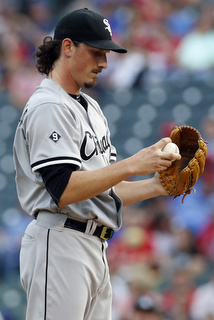
At this point I think Samardzija is what he is. Signing him and expecting his game to take a significant step forward probably isn’t realistic. He might — I think he will, not might — be better than he was this year simply because he figures to have a more competent defense behind him going forward, but I wouldn’t count on ever seeing the 2014 Samardzija again either. He’s talented and durable and the results leave you wanting more.
The Yankees love big power pitchers who don’t walk anyone — I think Samardzija’s improved walk rate the last two years is the result of an athletic pitcher getting locked into his mechanics — and Samardzija fits the bill. He’s also played for a team in a big market with intense media in the Cubs — shouldn’t his Notre Dame football experience count too? — and has an old school give me the damn ball bulldog mentality.
“Back in the day, the game was left in the starter’s hands,” said Samardzija to David Laurila in July 2014. “If the starter pitched well, he was given his 120 pitches. The game was decided by the starting pitchers. It’s different now and I think that’s unfortunate. When you get into tough situations, regardless of your pitch count, a lot of times a reliever is brought in. I understand why – it’s to preserve the game — but you have to keep your relievers’ arms fresh too. I like the idea of the starters deciding what happens in the game.”
I think the Yankees can use rotation help, and I’m sure if you gave the front office a truth serum, they’d say they want to find a way to upgrade the starting staff as well. If nothing else, it would be nice to have one guy you could count on to chew innings every fifth day, right? Asking the bullpen to get 10-12 outs a night is no way to go through a season (again). Samardzija can give you those innings.
Sinking four or five years and $17M annually into Samardzija to be an innings dude who is ideally your second or third best starter might be tough to swallow, but I think it is fair market value. If the Yankees intend to avoid huge money free agent contracts — like the one David Price will get, for example — Samardzija might just be their best option in free agency.






